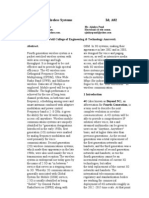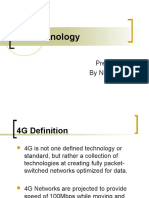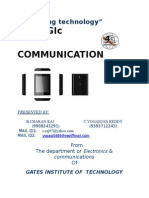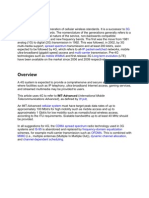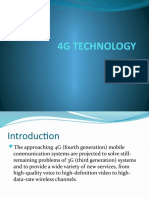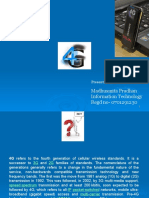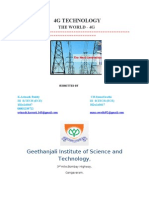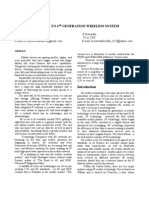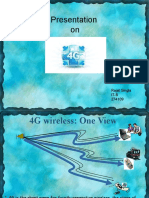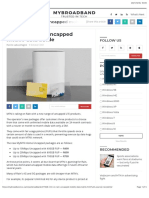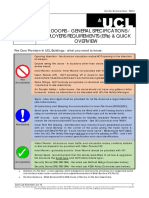Next Generation Wireless Standards: By: Vishnu Kayande Abstract
Next Generation Wireless Standards: By: Vishnu Kayande Abstract
Uploaded by
Lonar SarovarCopyright:
Available Formats
Next Generation Wireless Standards: By: Vishnu Kayande Abstract
Next Generation Wireless Standards: By: Vishnu Kayande Abstract
Uploaded by
Lonar SarovarOriginal Title
Copyright
Available Formats
Share this document
Did you find this document useful?
Is this content inappropriate?
Copyright:
Available Formats
Next Generation Wireless Standards: By: Vishnu Kayande Abstract
Next Generation Wireless Standards: By: Vishnu Kayande Abstract
Uploaded by
Lonar SarovarCopyright:
Available Formats
Next Generation Wireless Standards
Internet access right on their phones. But that is far from the limit of features; manufacturers entice customers to buy new phones with photo and even video A number of technologies currently exist to provide users with high-speed digital wireless connectivity; Bluetooth and 802.11 are examples. These two standards provide very high speed network connections over short distances, typically in the tens of meters. Meanwhile Cellular providers seek to increase speed on their long-range wireless networks. The goal is the same: long-range, high-speed wireless, which for the purposes of this report will be called 4G, for fourthgeneration wireless system. Such a system does not yet exist, nor will it exist in todays market without standardization. Fourthgeneration capability. It is no longer a quantum leap to envision a time when access to all necessary information. The power of a personal computer sits in the palm of ones hand. To support such a powerful system, we need pervasive, high-speed wireless connectivity. wireless needs to be standardized throughout the United States due to its enticing advantages to both users and providers. still-remaining problems of 3G systems. The 4G systems will interoperate with 2G and 3G systems, as well as with digital broadcasting systems and IP-based one. The term 4G is used broadly to include several types of broadband wireless access communication systems, not only cellular telephone systems. One of the term used to describe 4G is MAGIC(Mobile multimedia, anytime anywhere, Global mobility support integrated wireless solution, and customized personal service)
By: Vishnu Kayande Abstract:Consumers demand more from their technology. Whether it be a television, Cellular phone, or refrigerator, the latest technology purchase must have new features. With the advent of the Internet, the mostwanted feature is better, faster access to information. Cellular subscribers pay extra on top of their basic bills for such features as instant messaging, stock quotes, and even In this paper we analysis the channel capacity of wireless communication systems and to define the Shanon capacity is limitation and this capacity can be improved by using the number of transmitter and receiver antennas and it exploit the advantages and also increased through output, broad range in multipath fading environment and is capable to provide highest data capacity and also established a reliable wireless systems over the multipath fading channel that is known as 4G. Mobile communications and wireless networks are developing at an astounding speed. The approaching 4G mobile communication systems are projected to solve
The Only way to predict the Future is to invent it
Keyword:4G,Shannon Capacity, CDMA, TDMA, OFDM Introduction:-
FDMA,
THE HUMAN BEING IS SET APART from all animals by an intelligent, reasoning mind. Another quality that humans seem to posses is an inherent drive to utilize that mind to achieve, to recognize challenges, and to attempt to conquer them. From the dawn of the history, man has been lured to explore this world and to expand the horizons of his habitation. To accomplish the communication in ancient days there were kabootar, further post office were created now telephone, mobiles, emails, internet, sms, Bluetooth, are used by human more effectively for the purpose of communication. In 21st century people are looking for 4G. 4G is the fourth generation wireless network communications technology Standard. This new generation of wireless is intended to complement and replace the 3G systems. The 4G infrastructures will consist of a set of various networks using IP (Internet protocol) as a common protocol. Application adaptability and being highly dynamic are the main features of 4G services. The 4G systems will interoperate with 2G and 3G systems, as well as with digital (broadband) broadcasting systems. In addition, 4G systems will be fully IP-based wireless Internet. Where we are? :A. First Generation (1G): 1. Analog voice systems 2. No standardization B. Second Generation(2G): Digital voice systems 1. Currently deployed systems 2. CDMA, GSM (Global System for Mobile communication), PDC 3.
4. (Japan) D-AMPS (Digital Advanced Mobile Phone System) 5. PCS Systems C. Second Generation advanced (2.5G): Combining voice and data communications 1. Providing enhanced data rate 2. Two basic technologies: i. GSM-based (high baud rate) ii. GPRS (General Packet Radio Service) 3. Utilizes voice time slots to send packet traffic 4. An overlay over the existing voice system. D. Third Generation (3G): Digital voice and data communications . 1. Developing a more general mobile network. i. Handling Internet access, email, messaging, multimedia. ii. Access to any services (voice, video, data, etc.). iii. Requires high quality transmission. E. Forth Generation (4G): All-IP mobile networks: 1. Ubiquitous wireless communications. 2. Transparent to any services. 3. Integrating multi networks Comparison in 1G, 2G, 3G and 4G:The following table shows comparisons between some key parameters of 1G, 2G. 3G & 4G systems.
Technology Design began implementation Service
1G 19701984 Analog voice synchronous data to 9.6 Kbps
2G 19801991 Digital Voice, Short Messages 14.4 Kbps TDMA
3G 19902002 Higher capacity broad band data up to 2 Mbps 2 Mbps CDMA
4G 20002010? High capacity completely IP oriented multimedia data to 100 Mbps 100 Mbps OFDM
Data bandwidth 1 Kbps Multiplexing Defination:FDMA
4G is the short name for fourthgeneration wireless, the stage of mobile communications that will enable things like IP-based voice, data, gaming services and high quality streamed multimedia on portable devices with cable modem-like transmission speeds. 4G is the next evolution in wireless broadband connectivity, designed primarily for data transport versus voice networks pulling double-duty as data movers. Fourth Generation Technology. Technology used in 4G:1. 2. 3. 4. 5. 6. 7. WIMAX LTE UWB Smart antennas IPv6 VOIP OFDM
Correct definitions are the following: 802.16-2004 is often called 802.16d, since that was the working party that developed the standard. It is also frequently referred to as Fixed WiMAX" since it has no support for mobility. b) 802.16e-2005 is an amendment to 802.16-2004 and is often referred to in shortened form as 802.16e. It introduced support for mobility, among other things and is therefore also known as "Mobile WiMAX".
1. WIMAX:a) The terms "WiMAX(Worldwide Inter operability for Microwave Access), "Mobile WiMAX", "802.16d" and "802.16e" are frequently used incorrectly.
2. LTE:a) LTE is a set of enhancements to the Universal Mobile Telecommunications System (UMTS). With speeds up to 250 Mbps tested, LTE is a proprietary protocol being designed by carriers and equipment vendors such as AT&T, Verizon, Vodafone, T-Mobile and NTT DOCOMO. Regarding speed, LTE will be faster than current WiMAX networks, however 802.16m will close the speed gap. LTE Advantages: Fast, with peak data rates of 100 Mbps download and 50 Mbps upload. b) It makes CDMA and GSM debates moot. LTE will have lower latency, which makes realtime interaction on high band-width applications using mobiles possible.
Fig(b) Mobile IPv6 Fig(a) Lte 3. a) Smart Antennas:Definition: A smart antenna system combines multiple antenna elements with a signal processing capability to optimize its radiation and/or reception pattern automatically in response to the signal environment. b) Beam radio signals directly at a user to follow the user as they move. Allow the same radio frequency to be used for other users without worry of interference. Seamless s handoff between towers/access points. One transmit antenna, two receive antennas. 4. Mobile IPv6: a) More addresses than current version of IP protocol (Version 4) each device can have own IP Keep IP address even if you change access point. Presently translate IP with each change because not enough IP addresses to go around. b) IP Core-everything can talk to each other if they speak the same language. 5. Mobile VOIP: a) Voice Over Internet Protocol. Allows only packets (IP) to be transferred, eliminating complexity of 2 protocols over the same circuit. b) All voice data will be wrapped up in a packet lower latency data transmission (faster transmission) . c) Samples voice between 8,000 & 64,000 times per second and creates stream of bits which is then compressed and put into a packet. d) Increases battery life due to greater data compression .
Fig(c) Voip 6. OFDM: a) Orthogonal Frequency Division Multiplexing. b) Allows for transfer of more data than other forms of multiplexing (time, frequency, code, etc).
c) Simplifies the design of the transmitter & receiver. d) Allows for use of almost the entire frequency band No gaps to prevent interference needed. e) Currently used in WiMax(802.16) and Wi-Fi(802.11a/g).
train and till the network knows that they are in the train. B. Congestion Control:Congestion control will be another critical issues in the high performance 4G networks. Two basic approaches can be taken towards the congestion control : 1. avoidance or prevention of the congestion. 2. Detection and recovery after congestion. The avoidance scheme will require the network to suitably implement the admission control (measurement based or precomputed model) and scheduling techniques. The detection and recovery would require flow control and feedback traffic management. A conservative approach might be proposed for the 4G systems because of the wide variety of QoS requirements.
Fig(D) Ofdm Higher Layer Issues in 4G:4G is going to be a packet-based network. Since it would carry voice as well as internet traffic it should be able to provide different level of QoS. Other network level issues include Mobility Management, Congestion control, and QoS Guarantees : A. Mobility Management 1. Mobility Management includes location registration, paging and handover. The MT should be able to access the services at any place possible. The global roaming can be achieved by with the help of multi-hop networks that can include the WLANs or the satellite coverage in remote areas. A seamless service (Ex : soft handover of the MT from one network to another or from one kind of service to other) is also important. The hand-over techniques should be designed so that they make efficient use of the network (routing) and make sure that hand offs are not done too often. 2. New techniques in location management might be implemented. Each MT need not do location registration everytime. They can instead do concatenated location registration, which reports to the network that they are concatenated to a common object. Ex- MTs in a train need to re-register only when they get off the
C. Quality of Service (QoS) 4G systems are expected to provide real-time and internet-like services. The realtime services can be classified into five kinds: 1. Guaranteed : pre-computed delay bound is required for the service. Ex voice 2. Better: than-best effort : 3. Reductive : Service needs upper bound on end-to-end delay. 4. Controlled delay : service might allow dynamically variable delay. 5. Controlled load : Service needs resources (bandwidth and packet processing ). Guaranteed and Controlled Load services are proposed to appear in 4G.
Standards of next generation wireless:i. Faster and more reliable 100 Mb/s (802.11g wireless = 54Mb/s, 3G = 2Mb/s) ii. Lower cost than previous generation iii. Multi-standard wireless system Bluetooth, Wired, Wireless (802.11x) iv. Ad Hoc Networking v. IPv6 Core vi. OFDM used instead of CDMA vii. Potentially IEEE standard 802.11
ADVANTAGES AND DISADVANTAGES OF 4G: Advantages:
High usability: anytime, anywhere, and with any technology. Support for multimedia services at low transmission cost. Higher bandwidth, tight network security. Disadvantages:
Features of 4G Wireless Systems:The following are some possible features of the 4G systems: 1. Support interactive multimedia, voice, video, wireless internet and other broadband services. 2. High speed, high capacity and low cost per bit. 3. Global mobility, service portability, scalable mobile networks. 4. Seamless switching, variety of services based on Quality of Service (QoS) requirements 5. Better scheduling and call admission control techniques. 6. Ad hoc networks and multi-hop networks. 4G will create hybrid wireless networks using Ad Hoc networks. Form of mesh networking Very reliable. 7. It is typically detected as noise. 8. It can use any part of the frequency spectrum, which means that it can use frequencies that are currently in use by other radio frequency devices . 9. It uses a frequency of 3.1 to 10.6 Hz. 10. It uses less power , since it transmits pulse instead of continuous signal. 11. Special antennas are needed to tune and aim the signal. Applications: 1. Virtual Navigation 2. Tele-Medicine 3. Crisis Management Applications The equipment required to implement a next generation network is still very expensive. Carriers and providers have to plan carefully to make sure that expenses are kept realistic. Some new challenges in 4G 1.Multi-access interface, timing and recovery. 2. Higher frequency reuse leads to smaller cells that may cause intra-cell interference or higher noise figures due to reduced power levels. 3. The Digital to analog conversions at high data rates, multiuser detection and estimation (at base stations), smart antennas and complex error control techniques as well dynamic routing will need sophisticated signal processing. 4. Issues in the interface with the ad hoc networks should be sorted out. 4G systems are expected to interact with other networks like the Bluetooth, hiperlan, IEEE802.11b, etc. 5. Voice over multi-hop networks is likely to be an interesting problem because of the strict delay requirements of voice. 6. Security will be an important issue. 7. A new IP protocol might be needed because of the variable QoS services and the network should do better than best effort. 8. Networking protocols that adapt
dynamically to the changing channel conditions. 9. Seamless roaming and seamless transfer of services.
4) A modified IP will be the universal network layer protocol in the future. 5) Diverse array of applications like virtual navigation, tele-medicine, etc. 6) The entire network would be digital and packet switched.
Future:There are some good reasons for 4G development and a variety of current and evolving technologies to make 4G a reality. Both service providers and users want to reduce the cost of wireless systems and the cost of wireless services. Lesser the expensive of the system, the more people who will want to own it. 4G's flexibility will allow the integration of several different LAN and WAN technologies. Finally, the 4G wireless system would truly go into a "one size fits all" category, having a feature set that meets the needs of just about everyone.
7) Low cost high speeds data will drive forward the fourth generation (4G) as short- range communication emerges.
It is probable that the radio access network will evolve from a centralized architecture to a distributed one. 4G is likely to enable the download of full length songs or music pieces which may change the market response dramatically. Innovations in network technology will provide an environment in which virtually anything is available, anywhere, at any time, via any connected device. All totally the best way to help all users is to use 4G as the next wireless system and in totally it is safety and secure for public, this the need that demands the solution. Todays wired society is going wireless and if it has problem, 4G is answer. References:[1] [2] [3] [4] [5] http://www.owlnet.rice.edu/ http://www.umtsworld.com/ http://users.ece.gatech.edu/~jxie/4G/ http://voicendata.ciol.com/ Data Communication and networking- Behrouz A Forouzan
Conclusions:1) 4G is still in formative stages. They may become commercially available in 2011. 2) The work on 4G systems has begun in the industry as well the academia. Ex:Wireless World Research Forum (WWRF) has Ericcson, Alcatel, Nokia and Siemens AG. The National Science Foundation (NSF) has announced a program in 1999 that calls for proposals that would look at issues involved in 4G systems. In the USA, Motorola, Lucent, AT&T, Nortel and other major companies are also working on 4G systems.
3) Multimedia traffic will be dominant in the future. It is estimated that voice would contribute to only 20-30 % of total traffic in the future.
You might also like
- Sta. Fe National High School Extesion ClassDocument4 pagesSta. Fe National High School Extesion ClassJavan Ferry80% (5)
- The Matrix Screenplay Analysis Story MapDocument5 pagesThe Matrix Screenplay Analysis Story MapHitesh Sharma ૐ100% (3)
- Lab 3 StudentDocument18 pagesLab 3 Studentapi-238878100100% (6)
- Essential 4G Guide: Learn 4G Wireless In One DayFrom EverandEssential 4G Guide: Learn 4G Wireless In One DayRating: 4.5 out of 5 stars4.5/5 (12)
- Companies Details Contacts For U A EDocument1,413 pagesCompanies Details Contacts For U A Eqasi2000100% (1)
- SAP HCM Interview QuestionsDocument18 pagesSAP HCM Interview QuestionsAditya Deshpande100% (2)
- "4G Technology": Sri Venkateswara College of Eng & Tech.Document9 pages"4G Technology": Sri Venkateswara College of Eng & Tech.Venkatesh ChowdaryNo ratings yet
- Mobile Multimedia CommunicationDocument24 pagesMobile Multimedia CommunicationVikas KadamNo ratings yet
- Fourth Generation Wireless Systems 4G: AbstractDocument10 pagesFourth Generation Wireless Systems 4G: AbstractHarsha CharanreddyNo ratings yet
- Millimeter Wave Mobile Communication For 5G CellularDocument24 pagesMillimeter Wave Mobile Communication For 5G CellularVipinkumar HariharanNo ratings yet
- Presentation On 4G Wireless TechnologyDocument60 pagesPresentation On 4G Wireless TechnologycheezeshaNo ratings yet
- 4G Technology: Aakash Mehta Svbit Bhaumik Chaudhari SvbitDocument5 pages4G Technology: Aakash Mehta Svbit Bhaumik Chaudhari SvbitChaitanya MekaNo ratings yet
- Generations of Wireless Mobile Systems: Comparison of Channel Capacity For Different Channel TypesDocument2 pagesGenerations of Wireless Mobile Systems: Comparison of Channel Capacity For Different Channel TypesFranch Maverick Arellano LorillaNo ratings yet
- 4g TechnologyDocument7 pages4g TechnologyGaurav PatelNo ratings yet
- 4G Technology: Communication Skills and Soft Skills LabDocument5 pages4G Technology: Communication Skills and Soft Skills LabFermi NivedithaNo ratings yet
- 4g TelecommunicationDocument35 pages4g TelecommunicationBABAI5SNo ratings yet
- 4g Magic CommunicationDocument3 pages4g Magic CommunicationKashish PariNo ratings yet
- 4g Wireless System FullDocument6 pages4g Wireless System Fullkalbande86No ratings yet
- Welcome To The 4G Information SiteDocument6 pagesWelcome To The 4G Information SiteRishikesh AduNo ratings yet
- 4G Seminar ReportDocument31 pages4G Seminar ReportFazil AliNo ratings yet
- 4g Wireless TechnologyDocument25 pages4g Wireless Technologykrmukesh100% (1)
- Advancements Towards 4G: A Seminar ReportDocument44 pagesAdvancements Towards 4G: A Seminar ReportDinesh ChahalNo ratings yet
- 4G Technology: Presented by Akshay RathoreDocument26 pages4G Technology: Presented by Akshay RathoreRaj MohanNo ratings yet
- A Paper Presentation ON: Magic CommunicationDocument16 pagesA Paper Presentation ON: Magic CommunicationMohammed FaizanNo ratings yet
- 4G Technology: SLC'S Institute of Engg and TechnologyDocument9 pages4G Technology: SLC'S Institute of Engg and TechnologySIVA KRISHNA PRASAD ARJANo ratings yet
- 4G Technology: Presented by Nithin RajDocument26 pages4G Technology: Presented by Nithin RajMayank SharmaNo ratings yet
- 4G Technology: Presented by Nithin RajDocument26 pages4G Technology: Presented by Nithin RajEngyEmyNo ratings yet
- 5g Wireless TechnologyDocument26 pages5g Wireless TechnologyMadhu SaatwaduNo ratings yet
- 5G Literature ReviewDocument11 pages5G Literature ReviewAaron RodriguesNo ratings yet
- 4G Wireless Systems: Yuben JosephDocument8 pages4G Wireless Systems: Yuben JosephHashmi EugineNo ratings yet
- Ece3 - 4g Magic CommunicationDocument13 pagesEce3 - 4g Magic Communicationitabassum5No ratings yet
- 4g Technology AbstractDocument3 pages4g Technology AbstractPurnima KNo ratings yet
- 4G Technology: Presented Rahul SainiDocument26 pages4G Technology: Presented Rahul SainiPrabhat SharmaNo ratings yet
- 4GMOBILESDocument11 pages4GMOBILESapi-26871643100% (1)
- Rikka CommsDocument7 pagesRikka CommsGinu Rodavia Dela TorreNo ratings yet
- C Refers To The Fourth Generation of Cellular Wireless Standards. It Is A Successor ToDocument10 pagesC Refers To The Fourth Generation of Cellular Wireless Standards. It Is A Successor ToPrabahar RamasamyNo ratings yet
- 4G Technology: Presented By:-VijaylaxmiDocument24 pages4G Technology: Presented By:-VijaylaxmishridharbvbNo ratings yet
- 4G Mobile TechnologyDocument19 pages4G Mobile TechnologyHani TaHaNo ratings yet
- 4G Wireless System: K.Sudha Rani G.SruthiDocument20 pages4G Wireless System: K.Sudha Rani G.SruthiSudha Reddy KuluruNo ratings yet
- 4g Wireless SystemsDocument29 pages4g Wireless SystemsGajendra ShankhwarNo ratings yet
- Madhusmita Pradhan Information Technology Regd No-0701291230Document12 pagesMadhusmita Pradhan Information Technology Regd No-0701291230abakashdNo ratings yet
- 4G Full Paper GistDocument9 pages4G Full Paper GistSrini VasuluNo ratings yet
- 4G Technology: Presented By: KanganDocument18 pages4G Technology: Presented By: KanganKangan Sardar SinghNo ratings yet
- Paper Presentation On 4G Technology: Presented by K.CHARISHA& K.Ganga Bhavani B.Tech, ECE III YearDocument7 pagesPaper Presentation On 4G Technology: Presented by K.CHARISHA& K.Ganga Bhavani B.Tech, ECE III YearGanga BhavaniNo ratings yet
- 4gLTE CommunicationDocument12 pages4gLTE CommunicationDang NhzNo ratings yet
- 4G Technologies: Jishnu.S, Iii-Cse, Hindusthan Institute of TechnologyDocument12 pages4G Technologies: Jishnu.S, Iii-Cse, Hindusthan Institute of TechnologyJishnu NairNo ratings yet
- An Insight To 4 Generation Wireless SystemDocument11 pagesAn Insight To 4 Generation Wireless Systemvenkat4uuuNo ratings yet
- 4G and Its EvolutionDocument11 pages4G and Its EvolutionVamsee KrishnaNo ratings yet
- 4G Technology: Presented M.RajuDocument26 pages4G Technology: Presented M.RajuShital Solanki MakwanaNo ratings yet
- 4G-Beyond 3G and Wireless Networks: Indira Gandhi National Open University (IGNOU), Delh, IndiaDocument8 pages4G-Beyond 3G and Wireless Networks: Indira Gandhi National Open University (IGNOU), Delh, IndiaChara SukaNo ratings yet
- 4g - Mobile CommunicationDocument11 pages4g - Mobile CommunicationsrinivascbitNo ratings yet
- Multiple Access Techniques in 4G: Amritpal Kaur and DeepaliDocument3 pagesMultiple Access Techniques in 4G: Amritpal Kaur and DeepalipreetvibeNo ratings yet
- Presentation On: Rajat Singla It-B 274109Document25 pagesPresentation On: Rajat Singla It-B 274109Garima KapoorNo ratings yet
- Index: Sr. No. TopicDocument18 pagesIndex: Sr. No. TopicDinesh ChahalNo ratings yet
- 4g Mobile Communication System A Seminar Report (1) Computer Science Seminar TopicsDocument7 pages4g Mobile Communication System A Seminar Report (1) Computer Science Seminar TopicsfinitehourabyssNo ratings yet
- A Seminar Report On: Fourth Generation Mobile Communication SystemsDocument10 pagesA Seminar Report On: Fourth Generation Mobile Communication Systemsvks413No ratings yet
- 4G TechnologyDocument28 pages4G Technologyarpit109100% (3)
- John Appl 4GDocument12 pagesJohn Appl 4GAnnonymous963258No ratings yet
- 4g Communications BecDocument9 pages4g Communications BecSrini VasuluNo ratings yet
- 4G TechnologyDocument21 pages4G TechnologyvigneshknNo ratings yet
- 4 4g Wireless Systems OrgDocument31 pages4 4g Wireless Systems OrgrbakoliaNo ratings yet
- Fourth-Generation Technology: Abhinav Rai ROLL NO. 805004 C.S.E. Kiit Bhubaneshwar, OrissaDocument25 pagesFourth-Generation Technology: Abhinav Rai ROLL NO. 805004 C.S.E. Kiit Bhubaneshwar, OrissaGaurav SaralNo ratings yet
- mhdC8Vuv5Ntvq8MUqJCZI9Jo PDFDocument34 pagesmhdC8Vuv5Ntvq8MUqJCZI9Jo PDFAhmed58seribegawanNo ratings yet
- 4G TechnologyDocument26 pages4G TechnologytheshlagNo ratings yet
- Goals of True Broad Band's Wireless Next Wave (4G-5G)Document5 pagesGoals of True Broad Band's Wireless Next Wave (4G-5G)alokcena007No ratings yet
- Altivar Machine ATV320 - ATV320U15N4CDocument10 pagesAltivar Machine ATV320 - ATV320U15N4CKakmuza ZainNo ratings yet
- Evaluation Total Score: Placement Test Answer KeyDocument2 pagesEvaluation Total Score: Placement Test Answer KeyAnderson GonzalezNo ratings yet
- The Guide of Implementing Chat Protocol: Study Case On Using The Socket Programming Concept and Object Oriented ProgrammingDocument9 pagesThe Guide of Implementing Chat Protocol: Study Case On Using The Socket Programming Concept and Object Oriented ProgrammingJournal of Computing100% (1)
- Product-Overview 2012 ESU-KG en EbookDocument64 pagesProduct-Overview 2012 ESU-KG en EbookstefanofagnaniNo ratings yet
- A Study On Young Entrepreneurs-1Document58 pagesA Study On Young Entrepreneurs-1pavithra nirmalaNo ratings yet
- Incorrect. Please Review Mysql Key Capabilities To Find The Correct AnswerDocument12 pagesIncorrect. Please Review Mysql Key Capabilities To Find The Correct AnsweremedinillaNo ratings yet
- Wheat Leaf Disease Detection Using Image ProcessingDocument4 pagesWheat Leaf Disease Detection Using Image ProcessingEditor IJLTEMASNo ratings yet
- Bending and Compression To BS 5950 and BS en 1993-1-1Document5 pagesBending and Compression To BS 5950 and BS en 1993-1-1voegelchNo ratings yet
- Cisco Vs Juniper ComparativeDocument1 pageCisco Vs Juniper ComparativeReynaldo RossiNo ratings yet
- What Is Augmented Reality Marketing Its Definition, Complexity, and FutureDocument11 pagesWhat Is Augmented Reality Marketing Its Definition, Complexity, and FutureGalih EkaNo ratings yet
- Multi-Dimensional and Reconfigurable OrganizationDocument11 pagesMulti-Dimensional and Reconfigurable Organizationaakashgopalia100% (1)
- PricingDocument8 pagesPricingBherllyne JumillaNo ratings yet
- Manual Warp PyxisDocument13 pagesManual Warp PyxisPablo RuizNo ratings yet
- API Recommended Sucker-Rod Makeup Practices?: Wni ADocument4 pagesAPI Recommended Sucker-Rod Makeup Practices?: Wni Aamramazon88No ratings yet
- مراجعة اللغة الانجليزية للصف الاول الثانوي ترم اول مستر محمد فوزيDocument30 pagesمراجعة اللغة الانجليزية للصف الاول الثانوي ترم اول مستر محمد فوزيBahi AliNo ratings yet
- Line Conventions and Lettering: ASME Y14.2-2014Document5 pagesLine Conventions and Lettering: ASME Y14.2-2014John Paulo Guerta SerranoNo ratings yet
- Course Introduction To Uvm Session1 Systemverilog Primer For VHDL Engineers RsalemiDocument29 pagesCourse Introduction To Uvm Session1 Systemverilog Primer For VHDL Engineers RsalemiVictor David SanchezNo ratings yet
- A Framework For Social Media Data Analytics Using Elasticsearch and KibanaDocument9 pagesA Framework For Social Media Data Analytics Using Elasticsearch and KibanafestauNo ratings yet
- Quiz 1 - 18CS35Document20 pagesQuiz 1 - 18CS35Rashmi HarshaNo ratings yet
- MTN Vs Rain - Uncapped Mobile Data BattleDocument5 pagesMTN Vs Rain - Uncapped Mobile Data BattleOwm Close CorporationNo ratings yet
- Manoj Mathur ResumeDocument2 pagesManoj Mathur ResumeManoj MathurNo ratings yet
- Paper PDFDocument52 pagesPaper PDFVengatraman PondicherryNo ratings yet
- Series 1 Basic Tools of Combinational LogicDocument3 pagesSeries 1 Basic Tools of Combinational LogicChelsea LavonyaNo ratings yet
- Uclfire TN 013Document41 pagesUclfire TN 013herikNo ratings yet
- Essilor MR - Blue - 20-1Document132 pagesEssilor MR - Blue - 20-1Primoz DolinsekNo ratings yet

















